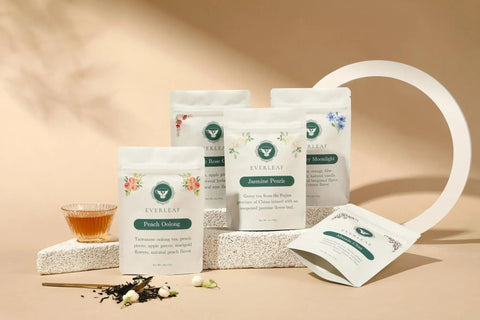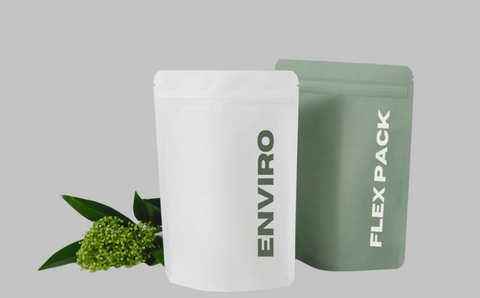Compostable Stand-Up Pouch Packaging: Why Kraft Paper Matters
There’s a kind of quiet charm to compostable kraft paper. It’s unpolished, a bit imperfect, and for some reason, people trust it. Maybe it's because it doesn’t look like it came from a factory line. It looks like it came from the earth, because, well, it sort of did.
In the world of compostable stand-up pouches, kraft paper holds a certain appeal. It doesn’t try too hard. It signals sustainability without screaming it. But designing packaging with kraft paper? It’s not always straightforward. You’re working with a material that soaks up ink like a sponge, shows every scuff, and flat-out refuses to look like plastic. And that’s exactly why it works, if you let it be what it is.
This isn’t a guide full of rules. It’s a collection of real tips, observations, and things we’ve learned from actually working with kraft pouches. Brown or white, textured or clean, they’ve got personality, and when you design with that in mind, the result feels right.
Why Kraft Paper Actually Works
Let’s talk about the material first. Kraft paper is made from wood pulp using a chemical process that keeps the fibers strong. That strength is part of what makes it ideal for packaging. It’s compostable, yes, but also durable enough to hold up through production, shipping, and a few kitchen counter shuffles.
There are two main versions. Brown kraft looks natural, unbleached, and rustic. It’s popular with coffee roasters, granola brands, tea sellers, anyone who wants to lean into that handmade, small-batch feel. Then there’s white kraft, which is bleached but still feels organic. It’s a good option if your brand needs a cleaner, more neutral canvas.
Check out our compostable stand up pouches or get a custom quote today!
Designing Around the Texture
This part matters. Kraft paper has a texture. It doesn’t hide anything. If your design relies on crisp, photo-quality detail, you might need to rethink it. Ink absorbs into the fibers, so colors soften a bit. Some would say they look faded. Others would say they look honest. Either way, it’s not the place for glossy gradients or high-definition photos.
What does work? Simple linework. Bold logos. A limited color palette. Spot colors hold up better than full-process printing. We’ve seen brands do beautiful things with just black ink and white space. Others use one pop color, like a deep green or warm orange, to create a focal point.
And yes, soy- or water-based inks are a must if you want the pouch to stay fully compostable.
Function First, Always
A pouch isn’t just a canvas, it has a job. It needs to hold product, stay sealed, stand up straight, and open without frustration. If any of that fails, the prettiest design in the world won’t save it.
When using kraft paper, this means making sure your compostable zipper actually zips. That your tear notch is clean. That your pouch has the right barrier layer for what you’re packing. Kraft paper alone doesn’t block oxygen or moisture very well. If you’re packing something that spoils or stales, you’ll need a liner, and yes, you can still keep it compostable.
Windows? They’re doable. Just be sure the clear film you’re using is compostable too. PLA works well, and it lets customers peek inside without compromising the sustainability story.
Don’t Waste the Opportunity to Say Something
Your pouch is a billboard. Use it. Talk about your materials. Show off your certifications. But do it plainly. People aren’t looking for corporate language. They want to know, in simple terms, how to dispose of it, what it’s made of, and why you chose it.
You don’t need paragraphs. A few honest sentences can do the job. Something like, "This pouch is made with FSC-certified kraft paper and lined with a compostable film. Compost it at home or through a commercial facility."
Icons help. The compost symbol, the BPI logo, clear directions on where to toss it when it’s empty, those little things go a long way.
A Quick FAQ, Based on What People Actually Ask
Q: Are kraft paper compostable pouches suitable for all products?
A: They’re best for dry or low-moisture goods like coffee, tea, snacks, or pet food. For oily or wet products, make sure you select kraft pouches with compostable barrier layers designed for those contents.
Q: How long do these pouches take to break down?
A: Industrial composting typically breaks them down in 90 to 180 days. Home composting varies widely and often takes longer.
Q: Can I print vibrant full-color designs on kraft paper?
A: Full CMYK printing is tough due to kraft’s texture and ink absorption. Spot colors or limited palettes produce better results while maintaining compostability.
Q: What certifications should I look for to ensure compostability?
A: The main ones to watch for are ASTM D6400, EN 13432, and BPI certification.
Q: Are kraft paper compostable pouches more expensive than plastic?
A: They often come with a small premium due to material and printing requirements. However, many brands find the investment worthwhile as consumer demand for sustainable packaging grows.
One Last Thought
The best kraft paper pouches don’t try to look like plastic. They don’t hide their texture or mute their personality. If anything, they lean into it. That’s the point.
Good design with kraft paper means letting the material do some of the work. Keep it simple. Keep it honest. If your values come through, your customers will notice. And they’ll remember.







Comments (0)
There are no comments for this article. Be the first one to leave a message!